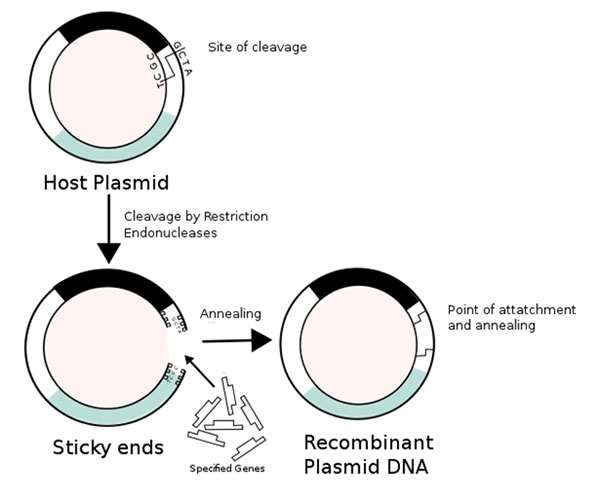Blog
In our last blog, we looked at genomic library construction and gene cloning. One important aspect of gene cloning is deciding what cloning vector you are going to use to create recombinant DNA. There are a variety of cloning vectors available and the one you choose will most likely depend on the segments of DNA you are interested in and the size of the DNA fragment you are cloning.
What is a cloning vector?
A cloning vector is a small piece of DNA that can remain stable in an organism and into which we can insert a foreign fragment of DNA for cloning. Regardless of which vector you choose; they all have common features. The vector must:
- Be capable of self-replicating inside the host cell
- Possess some sort of marker gene that can be used later to identify a recombinant cell
- Enable donor DNA to be introduced without interfering with the replication process
- Be easily isolated from the host cell
- Posses a unique restriction site for restriction enzymes
Types of cloning vectors
Several different types of cloning vectors can be used to clone DNA and the vector you choose will often depend on the size of the fragment you are cloning. Examples of different vector systems include plasmids, cosmids, bacteriophages, BAC, and YAC.

Plasmids
Plasmids are small, circular, double-stranded pieces of DNA that range in size, from 5 to 400kb. They are inserted into bacterial cells by a process called transformation, where they self-replicate, producing copies of the inserted DNA fragment. Plasmids can accommodate a DNA fragment of up to 10 kb in size. They also generally have a marker gene for antibiotic resistance, meaning cells containing the plasmid will grow in media containing the corresponding antibiotic.
Plasmids are commonly used for cloning DNA fragments. Source: Wikipedia Commons
Cosmids
A cosmid is a vector that has been engineered from a plasmid. It’s a type of hybrid plasmid as it also contains a Lamba phage cos sequence. A typical cosmid has an origin of replication, unique restriction sites, and selectable markers such as an antibiotic-resistant gene. Like plasmids, they can self-replicate in a host cell. Cosmids usually contain a DNA fragment of 45 kb, but this can range between 37 to 52 kb. Unlike plasmids, they can also be packaged into lambda particles which can be used to infect host cells. Cosmids are particularly useful for constructing eukaryotic genomic libraries because they can be used to clone large fragments of DNA.
Bacteriophage
A bacteriophage is a virus that infects bacteria. Phages are very simple in structure and are composed of a DNA or RNA molecule surrounded by a protective coat. Once the DNA fragment of interest has been inserted into the phage genome, the bacteriophage is inserted into a host cell where it replicates. These useful vectors accept large DNA fragments, from 30 – 50 kb in size. M13 vector is a common bacteriophage used in cloning. M13 also contains the lacZ gene which enables blue/white screening of colonies containing the DNA fragment.
Bacterial artificial chromosomes (BACs)
A BAC is an engineered DNA molecule that is used to clone DNA fragments in bacterial cells. BACs are often used in genome sequencing as they can be used to clone very large DNA fragments, ranging in size from 75 to 300 kb. Once BACs contain the DNA fragment of interest, they are taken up by bacterial cells which grow and divide, amplifying the DNA which can later be isolated and used in sequencing. BACs contain markers such as an antibiotic resistance gene to facilitate selection.
Yeast artificial chromosomes (YACs)
Yeast artificial chromosomes (YACs) are genetically engineered chromosomes that have been derived from the DNA of yeast. YACs are particularly useful for the mapping and sequencing of genomes because they can clone extremely large fragments of DNA, up to 1 Mb in length, although it is more common for YAC to be used to clone between 200 and 500 kb fragments. Once the fragments have been inserted, the YACs are taken up by yeast cells where they are propagated. As the fragments are so large, after cloning they can be physically mapped using a process called chromosome walking.
How We Can Help
Cepham Life Science offers several products and services that can help with gene cloning and genomic library preparations. For more information on our range of products have a look at our website or contact one of our team who will be happy to answer all your questions.
Contact Cepham Life Sciences
Cepham Life Sciences offer a quality and comprehensive range of research materials, and we are here to meet all your proteomics and molecular biology laboratory needs. Our team of experts will be happy to offer advice and any questions that you have. We are available at our office which is located at 705 Digital Drive, Suite S, Linthicum Heights, MD 21090. You can also reach us by phone at (410) 636-4954 or by email.
Follow us on Twitter, Facebook, Google+, and LinkedIn to keep up to date on all of our products and promotions. If you have any questions, reach out! We would love to hear from you.




